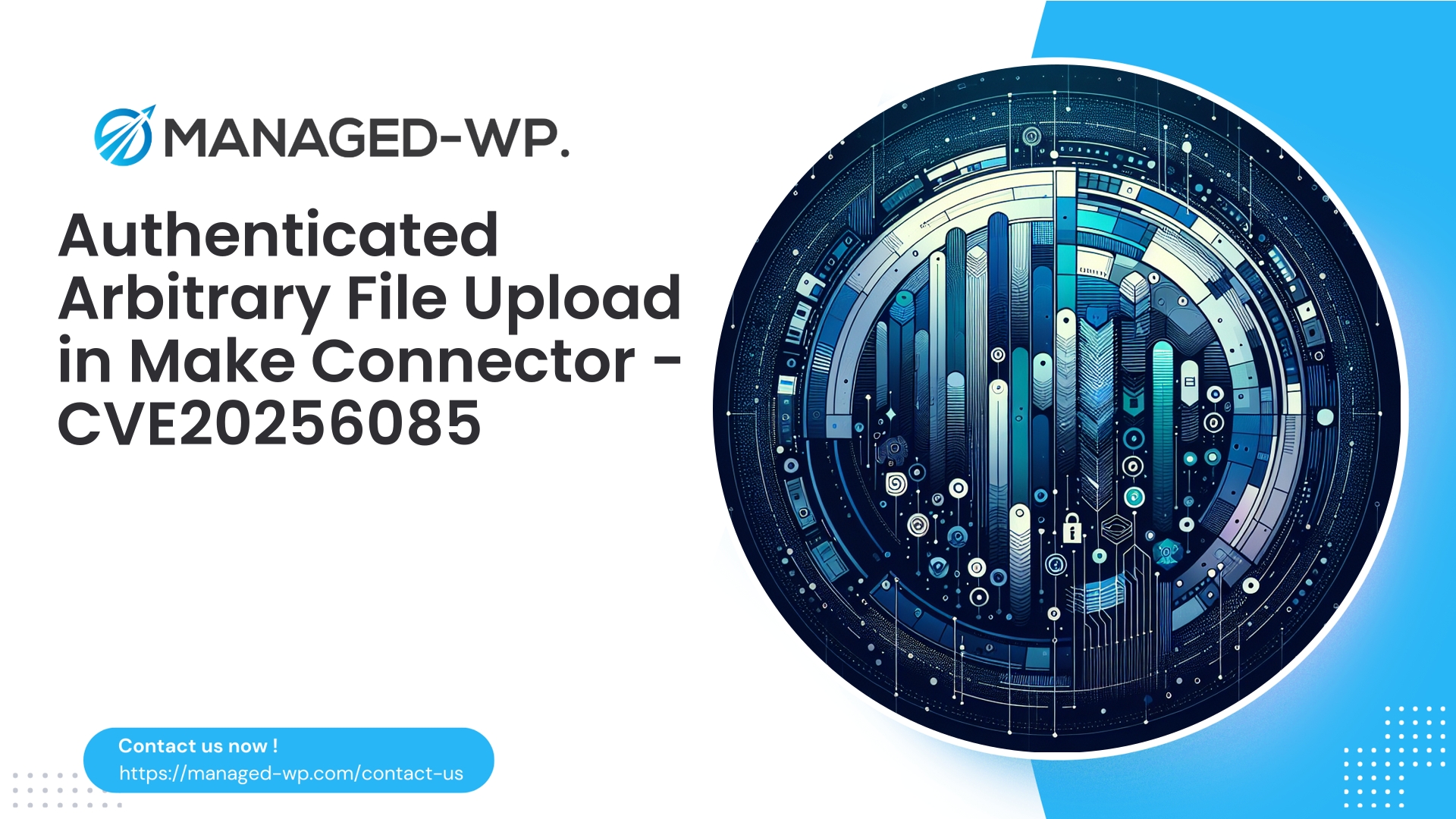| Plugin Name | Skyword API Plugin |
|---|---|
| Type of Vulnerability | Stored XSS |
| CVE Number | CVE-2024-11907 |
| Urgency | Low |
| CVE Publish Date | 2025-08-30 |
| Source URL | CVE-2024-11907 |
Skyword API Plugin (≤ 2.5.2) — Authenticated Stored XSS Vulnerability: Critical Insights for Site Owners and Developers
Published: August 30, 2025
CVE: CVE-2024-11907
At Managed-WP, we understand the significance of securing WordPress sites against emerging threats. A recently disclosed vulnerability in the Skyword API Plugin—impacting all versions up to 2.5.2 and patched in 2.5.3—allows authenticated users with Contributor-level permissions or higher to inject and store malicious JavaScript within the site. This stored cross-site scripting (XSS) flaw can result in code execution in the browsers of other visitors or administrators, posing a serious risk to site integrity and user safety.
This comprehensive briefing outlines the background of the vulnerability, identifies which WordPress instances are most at risk, and provides clear, actionable remediation steps. Additionally, we discuss how deploying a managed WordPress firewall and following best security protocols can effectively mitigate risk while you implement permanent fixes.
Executive Summary
- Vulnerability Type: Stored Cross-Site Scripting (XSS), requiring authenticated Contributor or higher privileges.
- Affected Plugin Versions: Skyword API Plugin ≤ 2.5.2.
- Patch Availability: Fixed in version 2.5.3 — immediate update recommended.
- Risk Level: Medium to high for multi-author setups, membership sites, and any environment accepting untrusted user content.
- Immediate Actions: Update plugin ASAP; if unable to update, apply virtual patching using WAF rules, restrict contributor roles temporarily, and scan for injected malicious content.
- Recommended Security Measures: Enforce least privilege, content sanitization, managed WAF deployment, malware scanning, and continuous monitoring.
Understanding Stored XSS and Its Impact in This Context
Stored XSS vulnerabilities occur when malicious scripts submitted by users are saved persistently within the application’s data store and served to other users without sufficient sanitization. Unlike reflected XSS, which is triggered by crafted URLs or inputs, stored XSS represents a lasting threat as the payload resides on the site until detected and removed.
Successful exploitation of the Skyword API Plugin vulnerability permits contributors or users with elevated permissions to embed JavaScript that executes in the browsers of site visitors or administrators. This can enable attackers to:
- Hijack authentication tokens or cookies, gaining unauthorized access.
- Execute actions on behalf of logged-in users, such as changing content or user privileges.
- Inject malicious advertisements, phishing forms, redirect traffic, or install cryptomining scripts in browsers.
- Target administrative users to further escalate access or inject backdoors.
Given the requirement for Contributor-level access to exploit this vulnerability, the risk heightens on multi-author sites, editorial platforms, or platforms where contributors are regularly added without strict vetting.
Who Should Take Immediate Notice
- WordPress sites using Skyword API Plugin versions 2.5.2 or older.
- Multi-author and editorial sites with numerous contributors or authors.
- Sites that display user-generated content in backend views, increasing attack surface.
- Websites with lax user role management or infrequent plugin updates.
If your environment fits any of the above scenarios, prioritize remediation without delay.
Why This Vulnerability Is Especially Dangerous
Two critical aspects amplify the severity of stored XSS vulnerabilities like this one:
- Persistence: Malicious code remains embedded on the site, potentially impacting multiple users over extended periods.
- Administrative Exposure: Payloads rendered in backend interfaces can compromise high-privilege accounts, opening doors for privilege escalation and site takeover.
Even if severity metrics rate this vulnerability as “low” or “medium,” the operational context could elevate risk significantly on high-traffic, multi-contributor platforms.
Immediate Remediation Checklist
- Upgrade Plugin to Version 2.5.3 or Later
- This update contains the official fix. Deploy it immediately.
- Test upgrades in staging if necessary, but prioritize timely production updates.
- If Immediate Update Is Not Possible
- Disable the plugin if feasible.
- Restrict Contributor-level role capabilities temporarily or remove untrusted accounts.
- Consider putting your site into maintenance mode during remediation.
- Apply Virtual Patching through Managed Firewall
- Deploy WAF rules to detect and block request patterns associated with stored XSS payload submissions targeting the plugin.
- Sanitize or block suspicious POST parameters until the plugin is updated.
- Enable any automatic rules your WAF provider offers for this vulnerability.
- Scan for Malicious Content
- Conduct comprehensive malware scans using plugin or server-side tools.
- Review recent content submissions by Contributors for suspicious JavaScript or encoded payloads.
- Search your database for known XSS signatures with caution to avoid false positives.
- Audit User Accounts and Credentials
- Review all users with Contributor or elevated roles.
- Reset passwords where appropriate, enforce two-factor authentication especially for admins.
- Inspect Admin Interfaces
- Look for unusual alerts, redirects, or script-generated pop-ups in backend dashboards.
- Review Logs for Anomalies
- Check access logs, AJAX and REST API call histories for suspicious or repeated attempts.
- Scrutinize firewall logs for blocked XSS attempts.
- Post-Update Validation and Cleanup
- Re-scan after plugin upgrades to remove lingering malicious scripts.
- Continuously monitor site behavior and logs for abnormal circumstances.
Finding Injected Payloads Safely
Detecting stored XSS payloads without executing harmful scripts requires careful technique:
- Query databases or exports for suspicious strings such as
<script>,onerror=,javascript:, or encoded versions. - Open suspect content in plain-text editors rather than web browsers.
- Utilize scanners designed to detect XSS patterns without rendering content.
- If previewing content is necessary, disable JavaScript or use sandboxed browsing environments.
Indicators of Compromise (IoCs)
- Presence of inline JavaScript tags or event attributes in contributor-submitted content.
- Unexpected backend alerts, redirects, or pop-ups.
- Creation of unknown admin users or elevation of privileges without authorization.
- Suspicious cron jobs or scheduled tasks indicative of unauthorized activity.
- Outbound connections to unrecognized domains.
- Unauthorized modifications to theme or plugin files.
Discovering IoCs should prompt immediate incident response protocols, including site isolation, log preservation, and consultation with security professionals.
Developer Best Practices: Preventing Stored XSS
Developers maintaining plugins or themes must adopt strong security hygiene:
- Always escape output using WordPress functions:
esc_html()for HTML content.esc_attr()for attributes.esc_url()for URLs.wp_kses()to whitelist safe HTML.
- Sanitize inputs on entry with functions like
sanitize_text_field()andwp_kses_post(). - Validate user capabilities before processing content (
current_user_can()checks). - Use nonces for form submissions to mitigate CSRF risks.
- Limit or strip dangerous HTML elements and attributes especially for lower-trust roles.
- Vet third-party code carefully and maintain updated dependencies.
These measures minimize the chance of persistent XSS vulnerabilities introduced via contributor content.
High-Level Guidance for WAF Rules and Virtual Patching
Implement virtual patches judiciously to limit exploitation risk before plugin updates are possible:
- Block requests containing raw
<script>tags or encoded equivalents in non-file uploads. - Filter event handler attributes like
onerror=,onclick=, andonload=. - Restrict base64-encoded payloads combined with suspicious functions such as
eval(). - Apply rules specifically to plugin endpoints to reduce false positives.
- Use rate limiting on new contributor accounts to throttle suspicious submission patterns.
Careful testing is required to balance security and functional editorial workflows.
How Managed-WP Helps Protect Your Site
Managed-WP offers a multi-layered security approach tailored for WordPress sites, recognizing the challenges of frequent plugin updates and complex editorial environments.
Our comprehensive protection includes:
- Managed WAF: Continually updated firewall rules that act as virtual patches, blocking exploit attempts for known vulnerabilities such as this stored XSS issue.
- Malware Detection: Regular scans of site content, files, and uploads to identify and quarantine threats early.
- Content Filtering: Optional controls that sanitize inputs from users with limited roles, reducing attack surface through policy enforcement.
- Role Hardening: Guidance and tools to audit and streamline user privileges based on actual needs.
- Incident Monitoring: Real-time alerts and logs to detect suspicious activity, enabling rapid response.
If updating immediately is a challenge, Managed-WP’s virtual patching and monitoring capabilities significantly reduce exposure time.
Post-Remediation Monitoring Strategy (30–90 Days)
- Week 1:
- Comprehensive malware rescan.
- Monitor WAF logs for blocked attacks.
- Enforce password resets and two-factor authentication for privileged accounts.
- Weeks 2–4:
- Audit contributor workflows and limit HTML permissions as needed.
- Review new user registration policies and implement captchas/email verification.
- Verify plugin and theme versions across all environments.
- Months 2–3:
- Schedule periodic vulnerability scans and patching cycle reviews.
- Develop formal vulnerability disclosure and response processes.
- Consider professional security audits for critical or high-traffic sites.
Incident Response Checklist
- Immediately isolate the affected site by disabling public access or network connections where possible.
- Preserve detailed logs including access, WAF, and database snapshots for forensic analysis.
- Reset all administrative passwords and revoke active sessions.
- Locate and remove malicious content and backdoors; engage WordPress-focused incident response experts if necessary.
- Reinstall plugins and themes from trusted sources, verifying integrity.
- Restore clean backups predating the incident where available.
- Communicate with stakeholders regarding possible data exposure or impact.
- Harden the environment post-cleanup and reactivate monitoring.
Recommended Patch Management and Maintenance Practices
- Prioritize rapid patch application for WordPress core and plugins, especially those that handle user input.
- Test critical updates in staging but maintain a schedule for timely production deployment.
- Keep updated inventories of plugins and their versions to assess risk exposure.
- Strictly enforce the principle of least privilege for all user roles to limit attack vectors.
Sample Policies for Multi-Author Editorial Sites
To mitigate risk in environments with routine contributor content:
- Implement editorial review workflows before publication.
- Use WYSIWYG editors configured to strip out script and event handlers.
- Educate contributors about safe content practices and dangers of embedding scripts.
- Apply both server-side sanitization on save and escaping on output display.
Adherence to these policies significantly reduces the risk of stored XSS introduced via contributor submissions.
Why Regular Updates Are Vital for WordPress Security
Timely updates address security vulnerabilities, interoperability issues, and performance optimizations. Neglecting updates, especially for plugins like Skyword API Plugin, leaves sites dangerously exposed.
The operational and reputational costs of a breach—including downtime, data loss, customer distrust, and cleanup expenses—far outweigh the effort required to maintain a healthy update regimen.
Automation can assist but should be combined with controlled testing to avoid disrupting critical functionalities.
Conclusion
The Skyword API Plugin stored XSS vulnerability underlines the ongoing need for comprehensive WordPress security strategies. Multi-author and editorial sites face amplified risks when contributors can persist executable scripts in site content.
Key priorities are:
- Update Skyword API Plugin to the latest patched version immediately.
- If updating is delayed, apply managed WAF rules, restrict contributor privileges, and scan for malicious content.
- Harden workflows and ensure safe content escaping within templates.
- Maintain vigilance through log monitoring and security alerts during and beyond remediation phases.
Effective protection comes from combining timely patching with proactive security controls and clear policies. Managed-WP is ready to support your security needs with expert services and tailored defenses.
Get Started Securing Your Site with Managed-WP Basic Firewall (Free)
To gain immediate, practical protection while you update your site, Managed-WP’s Basic plan offers essential defenses with simple deployment:
- Managed firewall with broad protections including OWASP Top 10 risk mitigation.
- Unlimited bandwidth and malware scanning included.
- No credit card required — quickly shield your site as you prioritize patching.
- Upgrade options available for automated malware removal, IP management, and advanced virtual patching.
Sign up for the free plan today: https://my.wp-firewall.com/buy/wp-firewall-free-plan/
If you’d like, Managed-WP can prepare a customized emergency checklist tailored to your site’s current state — including plugin inventory, user role listings, or recent logs — to prioritize your immediate next steps within 24 to 72 hours. Reach out with your details and we’ll assist promptly.



















